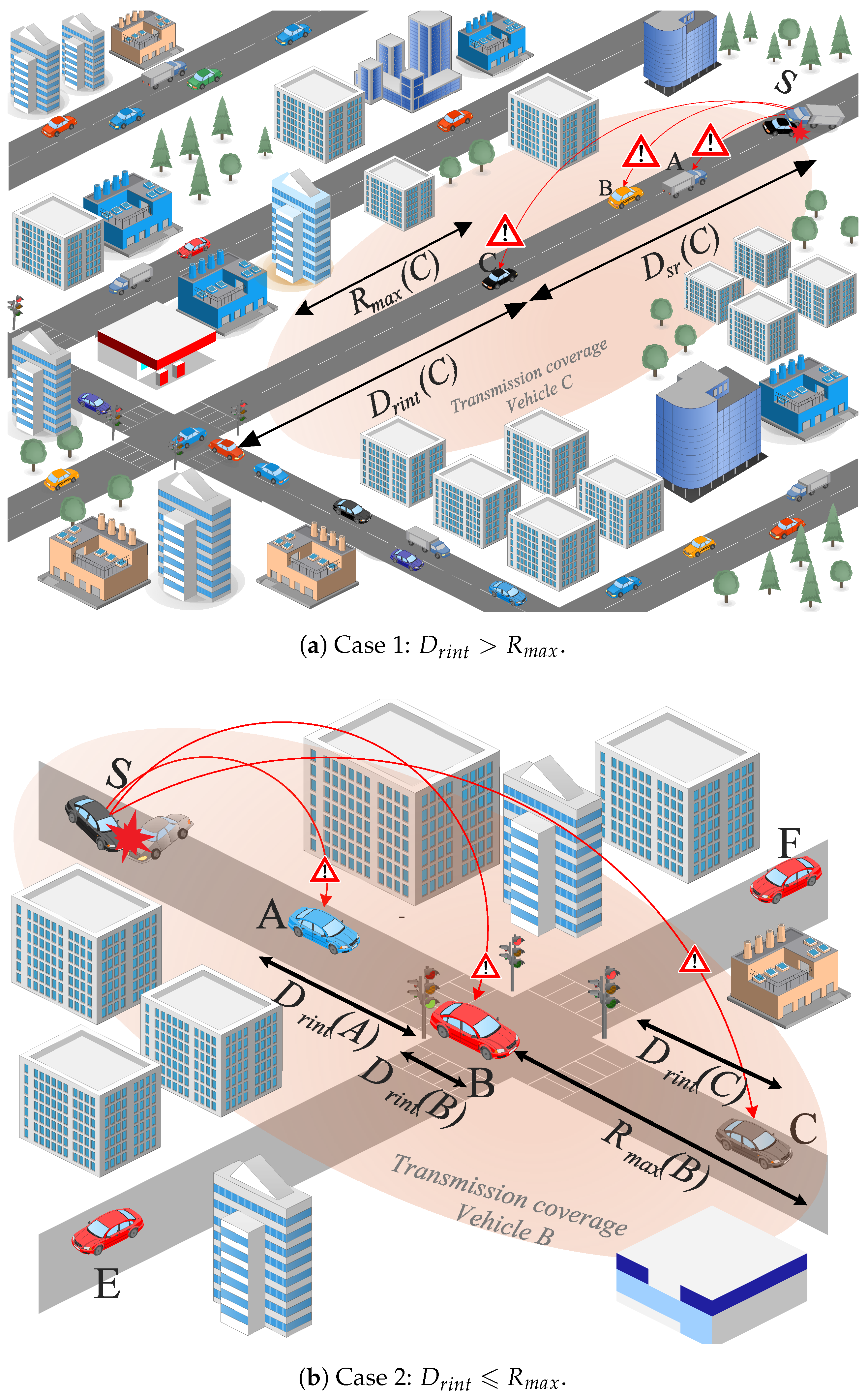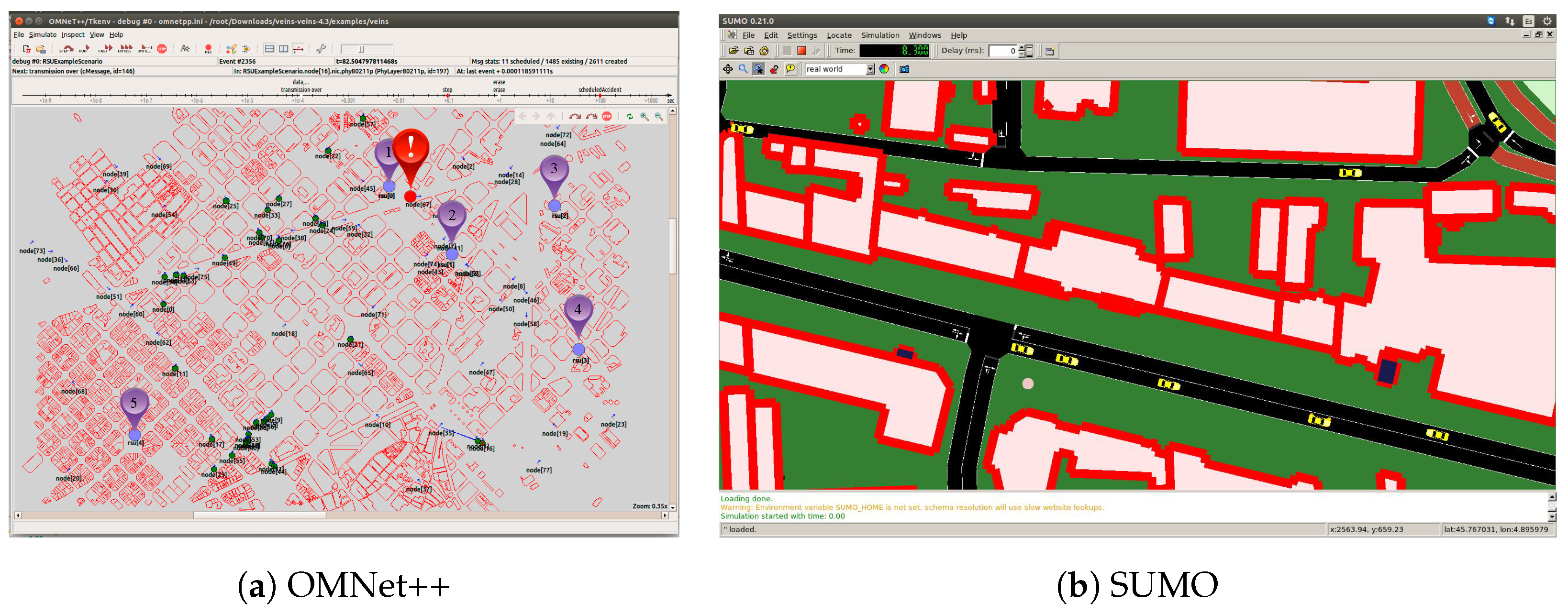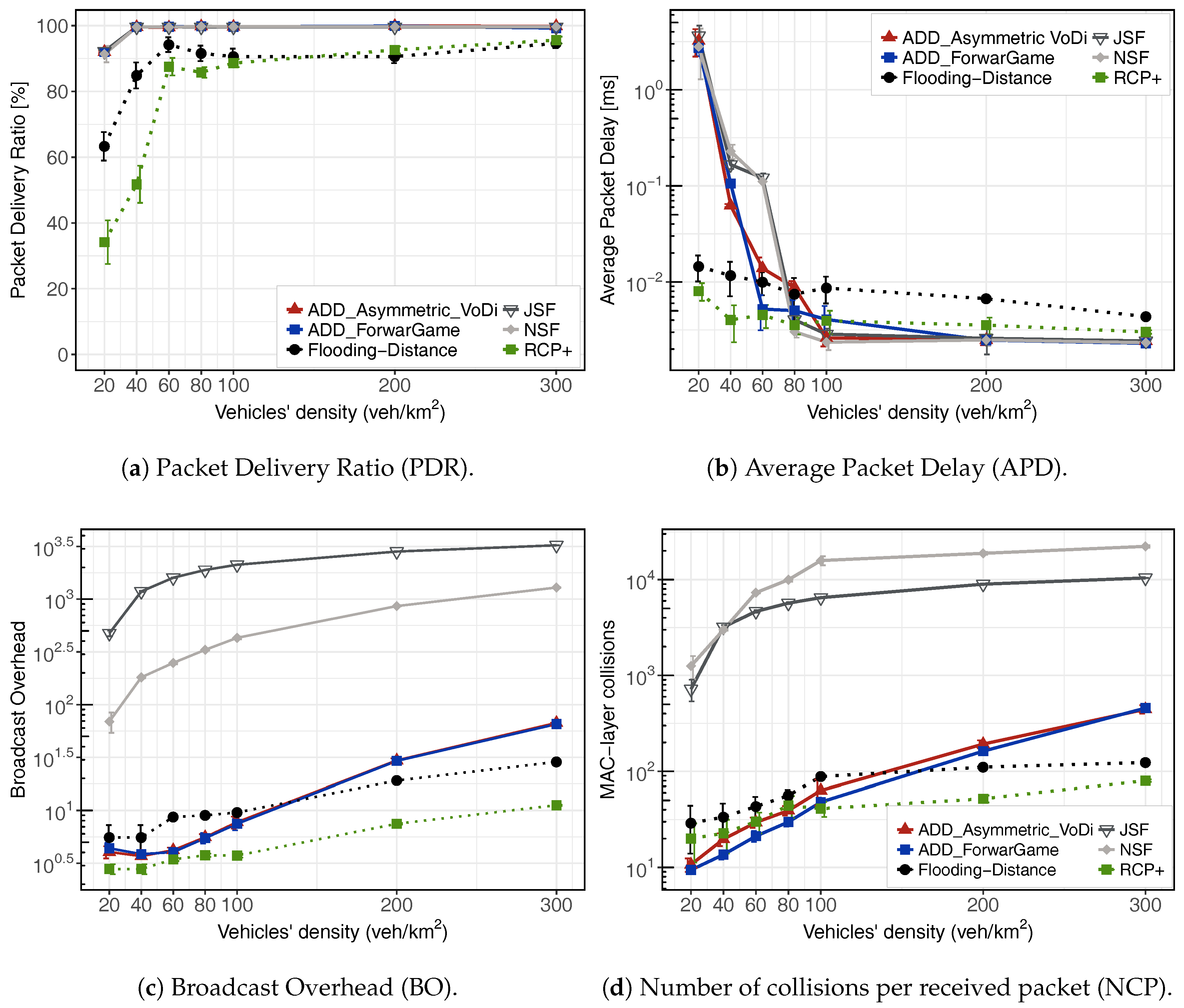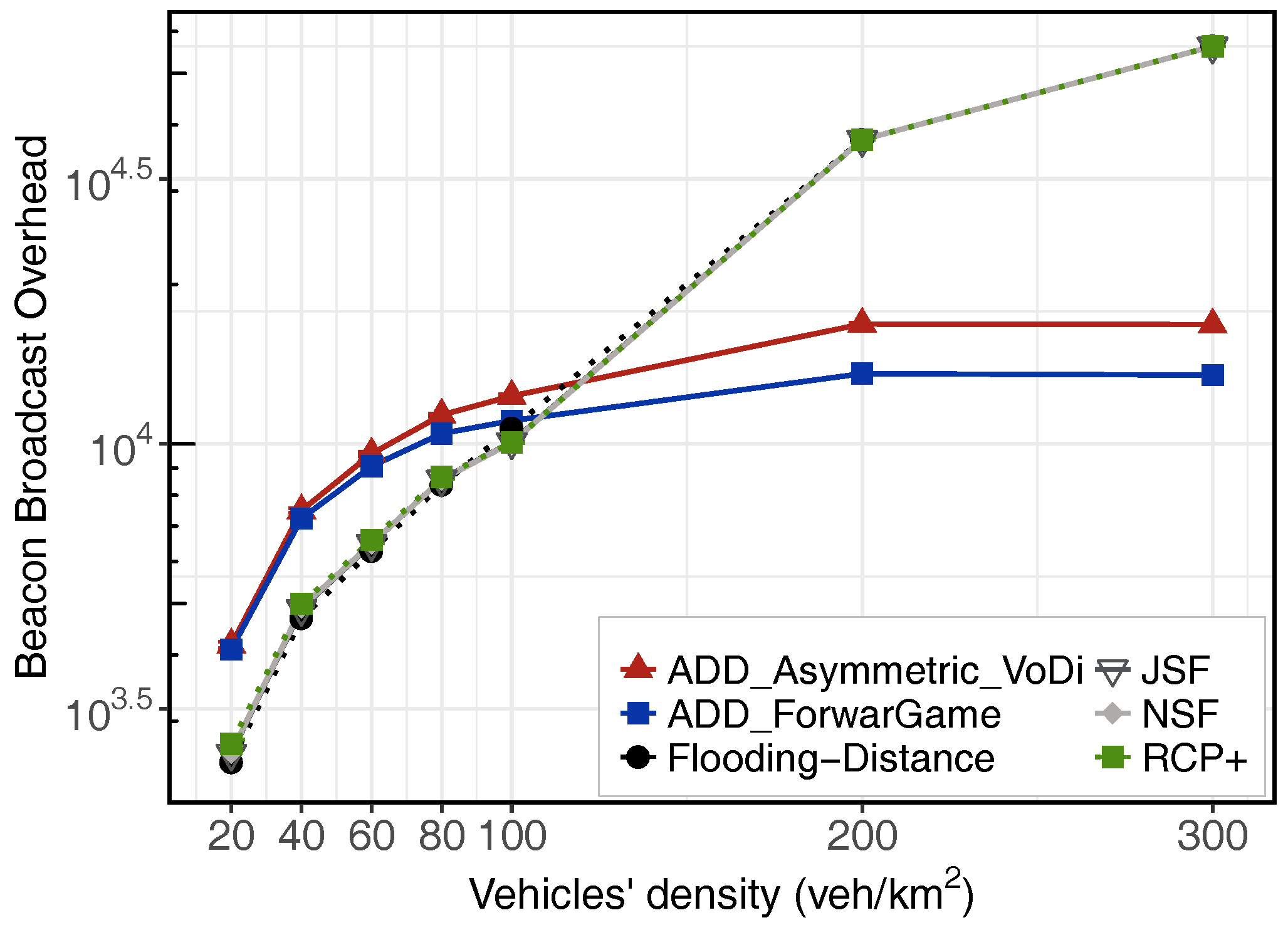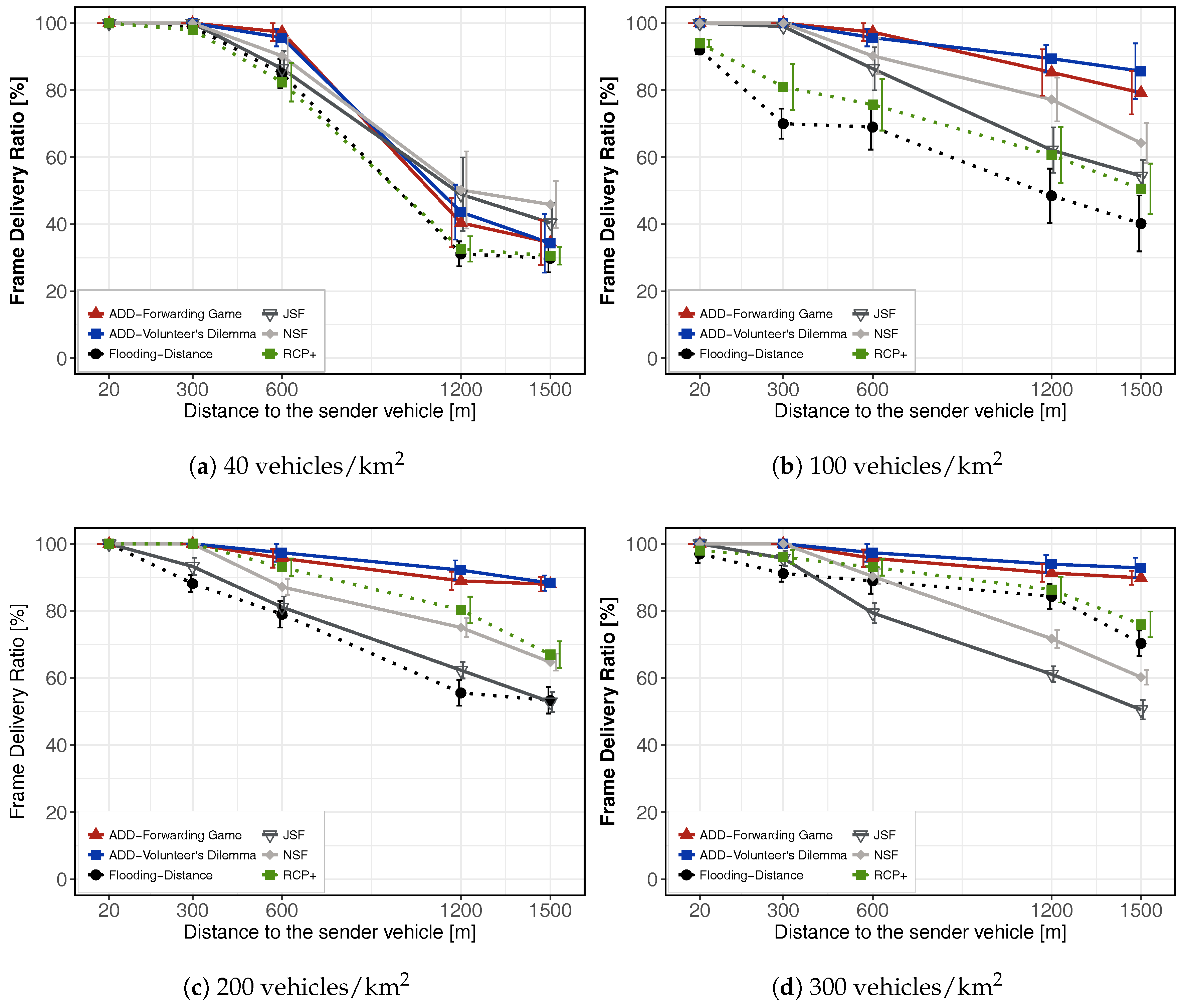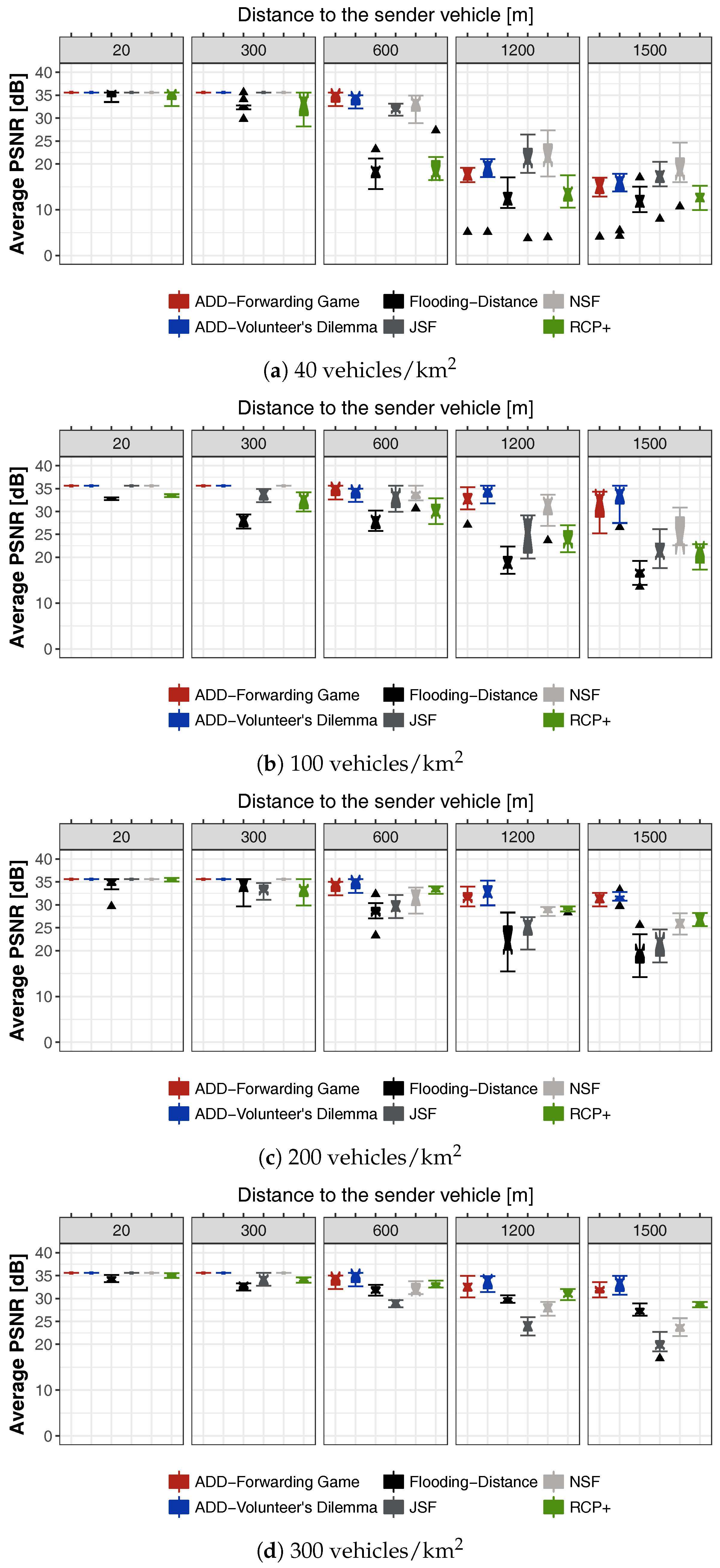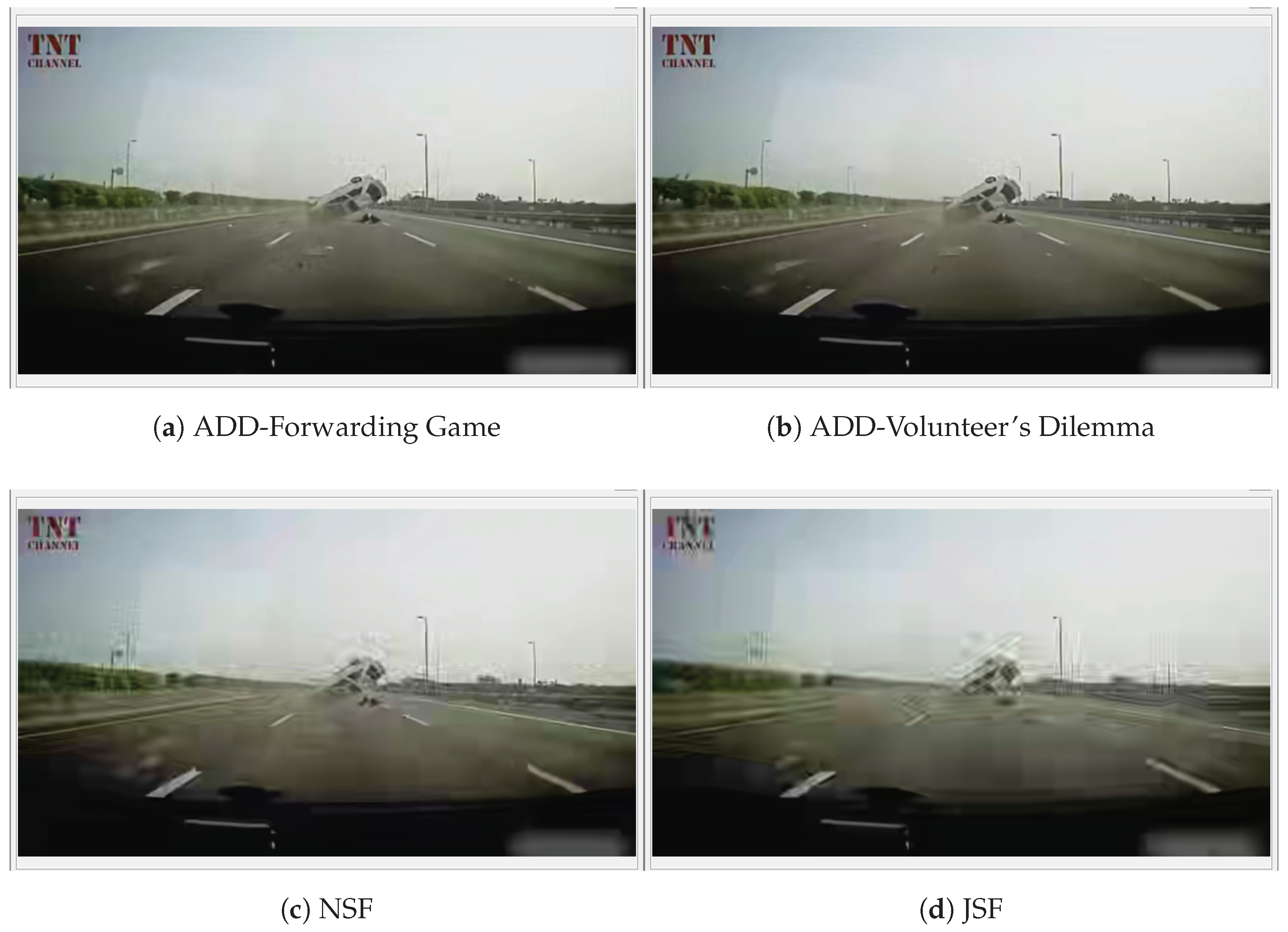As we have seen in the previous section, the purpose of Game Theory is to model interactions between players, to define different types of possible outcome, to predict the solution of a game under given information and behavior assumptions, and to design strategies to reach the outcomes. When an emergency message is received by a vehicle, the message should be re-broadcasted by that node. Nonetheless, in the shared wireless medium, unnecessary broadcasts degrade the performance of the network, which is known as broadcast storm problem. In our approach, neighbors of the source node play a game-theoretical algorithm upon receiving the emergency message, and they choose a forwarding probability as their strategy. The outcome of the game is the probability that each node forwards the emergency message.
4.1. Design of the Utility Function for the Asymmetric Volunteer’s Dilemma
Using the framework of the volunteer’s dilemma (VoDi) defined in
Section 3, we now formulate the VoDi to model warning messages dissemination in VANETs. We consider the special case of an asymmetric volunteer’s dilemma with increasing benefit earned by vehicle
i when at least one player volunteers (
) and strictly constant costs (
), i.e.,
where
. The costs
have been fixed to 1. This is not a limitation of the analysis. Quite the opposite, it is a grade of freedom of the game that could be used to extend the model based on the benefits earned by vehicle
i when at least one player volunteers.
Efficient delivery of messages in a VANET depends critically on the set of intermediate nodes which act as forwarding nodes. The behavior of the vehicle that received the message affects positively or negatively the behavior of other vehicles, depending on whether there was a choice of forwarding the message or not. We define several core strategies combined as an integral scheme to enhance the performance and the reliability of the warning message broadcast. Our proposal of utility function includes information about its local neighborhood and significant cross-layer information. Thus, the utility function for node
i is given by:
which is composed by two parameters related to information provided by vehicle
i: the position of the vehicle in the network (
) and an estimation of the congestion of the communication channel (
). ADD calculates the utility
, which is later used to compute its
in equilibrium. Higher values of
and
represent a better position of the vehicle and a better channel conditions, respectively (in the range
). Powers of base ten to make the relationship sensitive enough to environmental conditions. The weights
and
have been obtained through extensive simulations and under different traffic conditions, showing best results with those values. Nevertheless, we plan to design a dynamic scheme to update the weights of the multimetric score to calculate the utility function
for node
i as pointed out in
Section 7. We design the parameters of the utility function proposed in Equation (
14) as follows:
Distance factor : The distance factor is adapted to the information provided by the neighbor discovery process as well as to the information provided by the own GPS device. Thanks to the information gathered by beacon messages, the distance source–receiver
between transmitter and receiver can be calculated. On the other hand, the information provided by GPS allows us to know the receptor-intersection distance
to the next nearest intersection. If the receiving vehicle is not located over an intersection, the distance factor
is calculated as the ratio between
and the transmission range
. With this, the farthest vehicle from the sender is assigned the highest distance factor. On the other hand, if the receiving vehicle is located over an intersection, the distance factor
is calculated as a decreasing function of the distance
. This way, the lower
, the higher its
which means that the vehicle is a good candidate to broadcast the message. The distance factor is summarized in Equations (15a) and (15b).
where
is the relative distance between source
and receptor
vehicles,
is the relative distance between vehicle
and the next nearest intersection, and
is the transmission range.
As it can be seen in
Figure 1a, vehicles A, B, and C do not have intersections within their transmission range
. In this case, the vehicles receiving the message compute the distance factor according to Equation (15a). Thus, vehicle C which is farther from the sending vehicle S will be assigned the highest distance factor without taking into account its distance to the intersection, according to Equation (15a). On the other hand,
Figure 1b presents the scenario when the vehicles receiving the message have intersections within their transmission range. In this case, vehicles
A,
B, and
C compute the distance factor according to Equation (15b). Hence, vehicle B that is crossing the intersection is assigned the highest distance factor.
Link Quality factor : The Link Quality factor
is a metric designed to indicate the signal quality
, the channel quality
and the collision probability
, which are explained below. The vehicle
i receiving the message attains those parameters from its physical layer and MAC layer following a cross-layer design. The Link Quality factor is calculated as follows:
This way we equally add the effects of the signal quality and the channel being free of collision. The signal quality
aims at ensuring the integrity of the received message in vehicle
i, and it is calculated as follows:
where
is the ratio between the relative velocity (between the transmitter and the receiver of the warning message) and the maximum allowed velocity in the considered urban scenario. The velocity of the vehicle
i is an influencing parameter in signal quality because the communication link with a vehicle moving at a very high relative speed is less stable than with a vehicle moving at the lower relative speed. Therefore, vehicles moving at high relative speed will obtain low values of
.
is the ratio between the signal power and the noise intensity of the
i-th receiver. Note that those vehicles which are farther from the sender will have lower
.
is the received signal strength in vehicle
i bounded by 1 and it is defined using the following equation:
where
is the received signal strength,
is a threshold below which the received signal is considered too weak and
is the maximum value of the received signal strength.
The channel quality (
) is defined in Equation (
19) as an estimation of the state of the channel around the receiving vehicle
i at the time of reception of the message. The (
) is calculated using the Number of Successful Transmissions
and the Number of Overall Transmissions
in a window time. The Number of Successful Transmissions
is an internal statistical parameter that represents packets that were successfully processed in the medium access control (MAC) layer, that is to say, packets that do not suffer bit errors or collisions. A large number of packets lost over the last time window is an indicator that the quality of the channel is poor.
The collision probability
is defined in Equation (
20) as an estimation of the likelihood of a collision occurrence if the message is forwarded by the receiver vehicle
i. It is calculated using the channel occupancy time
and a fixed window time
in which the channel is observed. The channel occupancy time is computed by the MAC layer, which gives us the accumulated time that the channel was busy at the time of the query
t.
Once the utility function
has been computed, each vehicle inserts its
into the beacon message. As the beacon messages are received by each vehicle, they can calculate the factor
. When a vehicle creates an emergency message, it inserts the game information into the message, i.e., the factor
. When a vehicle receives an emergency message, it multiplies its current factor
by the factor included in the emergency message. In this instant, the vehicle
i is able to calculate its
in equilibrium according Equation (
5). Thus, the asymmetric volunteer’s dilemma game is played whenever vehicles receive a broadcast message and they choose in a decentralized way its best strategy.
4.2. Design of the Availability Function in the Forwarding Game
We have designed the availability function of a vehicle as a parameter () that measures the amount of available resources in the node i that make more efficient the process of disseminating emergency messages. This estimated value is a normalized average of two parameters: estimated available bandwidth and position of the node in the network.
Due to a possible large number of vehicles sharing the wireless medium, it is unclear whether the channel capacity is sufficient to support the data generated by beacon messages and at the same time leaving enough available bandwidth for supporting other applications. For the specific case of emergency video dissemination, the overall capacity of the channel can affect the effectiveness of emergency dissemination schemes if the density of potential forwarders is high. Definitely, available bandwidth estimation is a key component for quality of service (QoS) in VANETs. We have considered the
proposal presented in [
22] as one solution to estimate the available bandwidth in the link formed by two sender-receptor vehicles.
aims to provide an accurate estimation of the available bandwidth in the link formed between two neighbor nodes
s and
r, which can be estimated by the following equation:
where
is the proportion of bandwidth used by the back-off scheme which is estimated with Equation (
22).
is the collision probability measured on the received
packets and it is computed with Equation (
20).
is the idle time period at the sender side and
is the idle time period at the receiver node, and
C is the maximum medium capacity on link (
).
where
(in second) is the time elapsed between the emission of two consecutive frames,
(Distributed Coordination Function Interframe Space) is a fixed interval and
is the mean backoff used to transmit a single frame.
On the other hand, we have taken into account the position of the receiver node in the network to design a measure of the amount of available resources for vehicle i. As mentioned previously, vehicles located in intersections typically have better network connectivity than non-intersection vehicles. In addition, vehicles whose location is farthest from the source are potential forwarders in the process of message dissemination. In addition, position of the vehicles in the road-map has a large impact on the efficiency of dissemination due to the effect of buildings. With all these considerations, the position of the node is evaluated similarly to the distance factor presented in Equation (15).
To compute the availability
, we first divide
by the link capacity
, obtaining a normalized available bandwidth metric. A high value of
means a high available bandwidth in the link formed by both vehicles
s and
r. Next, we also consider the distance factor
as a function of the distance between the sender and the potential next forwarder
i, and the next nearest intersection
. Equation (
23) presents the availability function
of the potential forwarder.
where
is a weight to average both metrics.
Figure 2 shows the variables present in the Forwarding Game where each vehicle must select a strategy that maximizes its utility. Below we detail the Forwarding Game for the black vehicle
i. Each vehicle inserts its availability factor
into the beacon message. As the beacon messages are received by each vehicle, black vehicle
i can storage the availability factors
and
of its neighbors
and
C, respectively. When black vehicle
i receives an emergency message, it should compute the parameters availability factor
and neighbor action reflection
, as it is detailed in
Section 3.2. While the availability of vehicle
i depends exclusively on information of itself,
is estimated based on the information of the strategy of its neighbors (purple vehicles
A,
B and
C), i.e.,
allows us to estimate the parameter
. Note that red vehicles
D and
E are outside the transmission coverage of vehicle
i, so vehicle
i does not receive their beacons. Finally, vehicle
i selects its best strategy
to obtain a maximum utility
according Equation (
12). Thus, the forwarding game is played whenever vehicles receive a broadcast message and they choose in a decentralized way their best strategy to broadcast the message or not.
